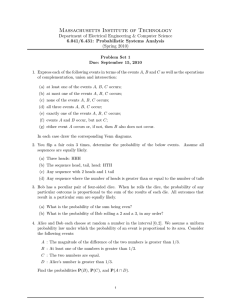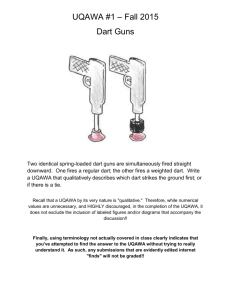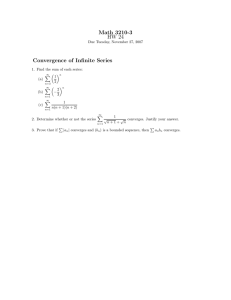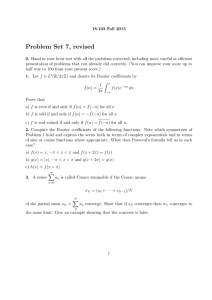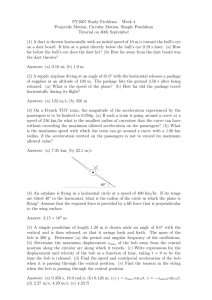Massachusetts Institute of Technology
advertisement
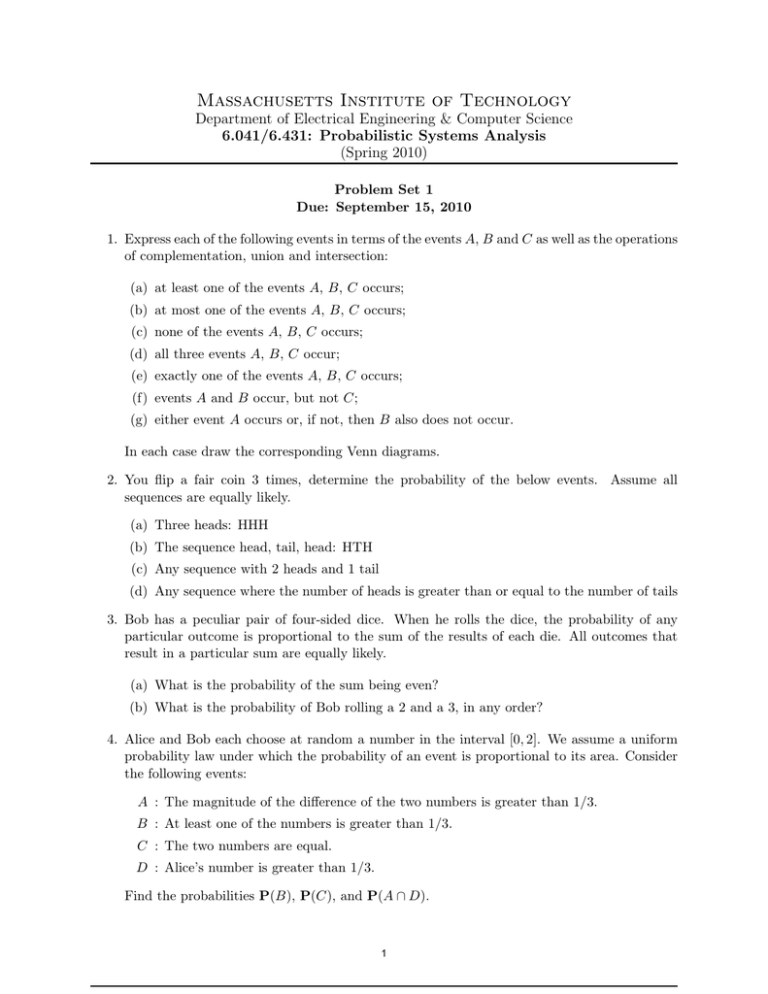
Massachusetts Institute of Technology
Department of Electrical Engineering & Computer Science
6.041/6.431: Probabilistic Systems Analysis
(Spring 2010)
Problem Set 1
Due: September 15, 2010
1. Express each of the following events in terms of the events A, B and C as well as the operations
of complementation, union and intersection:
(a) at least one of the events A, B, C occurs;
(b) at most one of the events A, B, C occurs;
(c) none of the events A, B, C occurs;
(d) all three events A, B, C occur;
(e) exactly one of the events A, B, C occurs;
(f) events A and B occur, but not C;
(g) either event A occurs or, if not, then B also does not occur.
In each case draw the corresponding Venn diagrams.
2. You flip a fair coin 3 times, determine the probability of the below events. Assume all
sequences are equally likely.
(a) Three heads: HHH
(b) The sequence head, tail, head: HTH
(c) Any sequence with 2 heads and 1 tail
(d) Any sequence where the number of heads is greater than or equal to the number of tails
3. Bob has a peculiar pair of four-sided dice. When he rolls the dice, the probability of any
particular outcome is proportional to the sum of the results of each die. All outcomes that
result in a particular sum are equally likely.
(a) What is the probability of the sum being even?
(b) What is the probability of Bob rolling a 2 and a 3, in any order?
4. Alice and Bob each choose at random a number in the interval [0, 2]. We assume a uniform
probability law under which the probability of an event is proportional to its area. Consider
the following events:
A : The magnitude of the difference of the two numbers is greater than 1/3.
B : At least one of the numbers is greater than 1/3.
C : The two numbers are equal.
D : Alice’s number is greater than 1/3.
Find the probabilities P(B), P(C), and P(A ∩ D).
1
Massachusetts Institute of Technology
Department of Electrical Engineering & Computer Science
6.041/6.431: Probabilistic Systems Analysis
(Spring 2010)
5. Mike and John are playing a friendly game of darts where the dart board is a disk with radius
of 10in.
Whenever a dart falls within 1in of the center, 50 points are scored. If the point of impact is
between 1 and 3in from the center, 30 points are scored, if it is at a distance of 3 to 5in 20
points are scored and if it is further that 5in, 10 points are scored.
Assume that both players are skilled enough to be able to throw the dart within the boundaries
of the board.
Mike can place the dart uniformly on the board (i.e., the probability of the dart falling in a
given region is proportional to its area).
(a) What is the probability that Mike scores 50 points on one throw?
(b) What is the probability of him scoring 30 points on one throw?
(c) John is right handed and is twice more likely to throw in the right half of the board
than in the left half. Across each half, the dart falls uniformly in that region. Answer
the previous questions for John’s throw.
6. Prove that for any three events A, B and C, we have
P(A ∩ B ∩ C) ≥ P(A) + P(B) + P(C) − 2.
G1† . Consider an experiment whose sample space is the real line.
(a) Let {an } be an increasing sequence of numbers that converges to a and {bn } a decreasing
sequence that converges to b. Show that
lim P([an , bn ]) = P([a, b]).
n→∞
Here, the notation [a, b] stands for the closed interval {x | a ≤ x ≤ b}. Note: This
result seems intuitively obvious. The issue is to derive it using the axioms of probability
theory.
(b) Let {an } be a decreasing sequence that converges to a and {bn } an increasing sequence
that converges to b. Is it true that
lim P([an , bn ]) = P([a, b])?
n→∞
Note: You may use freely the results from the problems in the text in your proofs.
2
MIT OpenCourseWare
http://ocw.mit.edu
6.041 / 6.431 Probabilistic Systems Analysis and Applied Probability
Fall 2010
For information about citing these materials or our Terms of Use, visit: http://ocw.mit.edu/terms.
